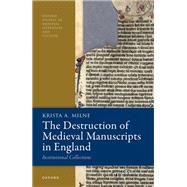The Destruction of Medieval Manuscripts in England Institutional Collections
, by Milne, Krista A.- ISBN: 9780198920229 | 0198920229
- Cover: Hardcover
- Copyright: 7/24/2025
The Dissolution of the Monasteries (1536-40) is widely held as the single most significant event in England's history of the destruction and loss of medieval manuscripts. Despite this consensus, the ultimate impact of the Dissolution - and of medieval manuscript destruction during the centuries that followed - remains unclear. How did Reformation-era losses compare to those which preceded the Reformation, and to those that followed it? How did the losses caused by sectarian conflicts compare to more quotidian kinds of loss, such as improper storage or deliberate de-acquisition? Which manuscripts were targeted, when were they targeted, and how should one account for the inevitably skewed record?
In The Destruction of Medieval Manuscripts in England, Krista A. Milne asks these questions to better understand literary taste, behavioural patterns, and the circulation of knowledge throughout the medieval period. Milne explores methods drawn from quantitative codicology to explore the most significant moments of manuscript loss in the history of England. The evidence suggests that this destruction was much more limited in its targets, but far more extensive in scope, than is usually acknowledged. Overwhelmingly, throughout the investigation, the manuscripts most at risk were those considered too new to qualify as antique but too old to be au courant. This pattern of destruction, which Milne describes as the principle of 'age without vintage,' remains apparent in many different domains today.
In The Destruction of Medieval Manuscripts in England, Krista A. Milne asks these questions to better understand literary taste, behavioural patterns, and the circulation of knowledge throughout the medieval period. Milne explores methods drawn from quantitative codicology to explore the most significant moments of manuscript loss in the history of England. The evidence suggests that this destruction was much more limited in its targets, but far more extensive in scope, than is usually acknowledged. Overwhelmingly, throughout the investigation, the manuscripts most at risk were those considered too new to qualify as antique but too old to be au courant. This pattern of destruction, which Milne describes as the principle of 'age without vintage,' remains apparent in many different domains today.






